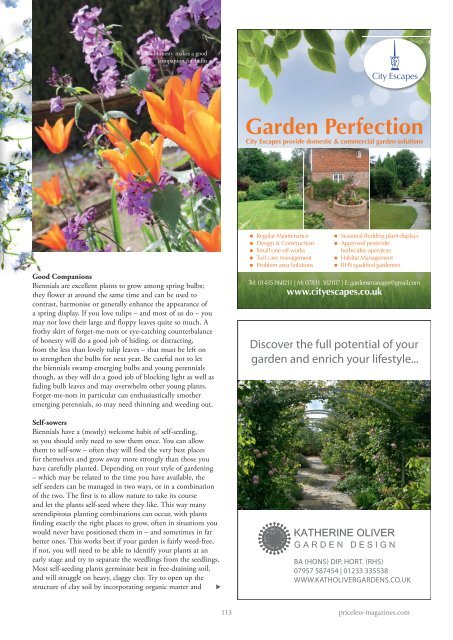Surrey Homes | SH76 | May 2021 | Restoration & New Build supplement inside
The lifestyle magazine for Surrey - Inspirational Interiors, Fabulous Fashion, Delicious Dishes
The lifestyle magazine for Surrey - Inspirational Interiors, Fabulous Fashion, Delicious Dishes
Create successful ePaper yourself
Turn your PDF publications into a flip-book with our unique Google optimized e-Paper software.
Honesty makes a good<br />
companion for bulbs<br />
Garden Perfection<br />
City Escapes provide domestic & commercial garden solutions<br />
Good Companions<br />
Biennials are excellent plants to grow among spring bulbs;<br />
they flower at around the same time and can be used to<br />
contrast, harmonise or generally enhance the appearance of<br />
a spring display. If you love tulips – and most of us do – you<br />
may not love their large and floppy leaves quite so much. A<br />
frothy skirt of forget-me-nots or eye-catching counterbalance<br />
of honesty will do a good job of hiding, or distracting,<br />
from the less than lovely tulip leaves – that must be left on<br />
to strengthen the bulbs for next year. Be careful not to let<br />
the biennials swamp emerging bulbs and young perennials<br />
though, as they will do a good job of blocking light as well as<br />
fading bulb leaves and may overwhelm other young plants.<br />
Forget-me-nots in particular can enthusiastically smother<br />
emerging perennials, so may need thinning and weeding out.<br />
Self-sowers<br />
Biennials have a (mostly) welcome habit of self-seeding,<br />
so you should only need to sow them once. You can allow<br />
them to self-sow – often they will find the very best places<br />
for themselves and grow away more strongly than those you<br />
have carefully planted. Depending on your style of gardening<br />
– which may be related to the time you have available, the<br />
self seeders can be managed in two ways, or in a combination<br />
of the two. The first is to allow nature to take its course<br />
and let the plants self-seed where they like. This way many<br />
serendipitous planting combinations can occur, with plants<br />
finding exactly the right places to grow, often in situations you<br />
would never have positioned them in – and sometimes in far<br />
better ones. This works best if your garden is fairly weed-free,<br />
if not, you will need to be able to identify your plants at an<br />
early stage and try to separate the weedlings from the seedlings.<br />
Most self-seeding plants germinate best in free-draining soil,<br />
and will struggle on heavy, claggy clay. Try to open up the<br />
structure of clay soil by incorporating organic matter and <br />
■<br />
■<br />
■<br />
■<br />
■<br />
Regular Maintenance<br />
Design & Construction<br />
Small one off works<br />
Turf care management<br />
Problem area Solutions<br />
■<br />
■<br />
■<br />
■<br />
Seasonal Bedding plant displays<br />
Approved pesticide/<br />
herbicides operators<br />
Habitat Management<br />
RHS qualified gardeners<br />
Tel: 01435 868211 | M: 07831 302107 | E: gardensmanager@gmail.com<br />
www.cityescapes.co.uk<br />
CityEscapesWT204.indd 1 24/01/2019 10:40<br />
Discover the full potential of your<br />
garden and enrich your lifestyle...<br />
BA (HONS) DIP. HORT. (RHS)<br />
07957 587454 | 01233 335538<br />
WWW.KATHOLIVERGARDENS.CO.UK<br />
113 priceless-magazines.com<br />
KatherineOliverGardenDesignWT227.indd 1 01/03/<strong>2021</strong> 16:34


















